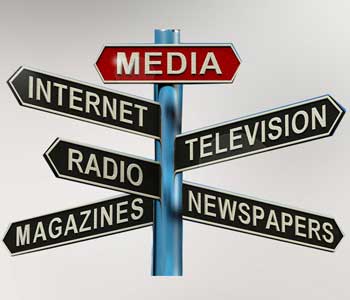Press Release Writing Services
For individuals, businesses and organizations

“Next to doing the right thing, the most important thing is to let people know you are doing the right thing.”
~ John D. Rockefeller, Diplomat
Press releases get the word out to professional media
A press release is a short news story directed to members of the media, announcing an upcoming newsworthy event, product or service. The goal is to achieve coverage in publications, or on radio or TV. A good release answers the questions of “who, what, when, where and why.” It will also give the name and contact info of the person representing the company and/or a designated media contact for any questions.
A press release only works in the right hands
Producing a well-written press release, although no small feat, is only half of the job. Success depends on the release reaching the right media people so it has a chance to achieve the desired result of publicity. It helps if it is well-written and the topic is actually newsworthy. How to reach the right people?
It’s essential to build a good relationship with the press, particularly targeted individuals and outlets in the field you represent. They would be more likely to read a release that came from your company and to act upon it. Compile a well-researched media list with current names and contact information and keep it updated with individuals you know to be reputable and who perform. Take the time to cultivate those relationships and to give them what they need in return.
Use links on press releases
Inserting hyperlinks in the press release is a good way to broaden online exposure. For instance, if the release on XYZ Inc. claims that they will announce their upcoming move to the historic ABC Building, you can hyperlink the ABC Building, bringing in that website and group of people. Of course always insert a hyperlink to the website of the company which is the subject of the release.
Different types of press releases
Guidelines for a press release
A good release starts with the date, place of issue and the words: “For Immediate Release.” It is usually one page. The headline will be fairly short but catchy, to capture attention. The news to be announced leads off the first paragraph and the next few paragraphs give explanations, usually supported by a quote. Contact information can be given at the top or bottom of the release.
What is considered newsworthy for press release
While the press release format follows certain guidelines, the subjects covered by a release come from a broad range of topics.
The release could be announcing a new product or a new line, especially if it deviates from traditional products. It could be announcing an increase or decrease in personnel and the potential benefit. Perhaps the company will save money by downsizing and will be able to offer more individualized attention to customers.
Another important announcement could be that the company is adding services. Free shipping may be provided with orders over a certain price, or shipping service is to include drones delivering to the customer’s doorstep, commencing at a designated date. The body of the text can expand on that service and what it will mean to customers.
A company may be suspending print publications and want to inform customers that information will only be available online.
Change of personnel can be important, and it doesn’t have to be in the executive suite. For instance, a restaurant chain would want to announce a new chef, especially if that individual has a good reputation in the business and a following. A celebrity chef would certainly be worthy of a press release.
If the company is moving to a new location, a press release is a good way to get the news out. The release would include a description of the new space, the benefits of the new location, and what the change will mean to the company’s success.

“You did an outstanding job, and your press release is such a help. It is not only nicely written but also
an important contribution for all of us right now, given my schedule. You have helped me so much with
this, and I am so thankful.“
Jordan Kiper, Ph.D. Candidate, University of Connecticut
What it takes to write a good press release
“In public relations, you live with the reality that not every disaster can be made to look like a misunderstood triumph.”
~ Christopher Buckley
“Cori is so easy to work with and provides a seamless link between our club clients and corporate resources. Although she never hesitates to ask questions to ensure she understands a project, she works well independently and I always feel confident she will keep things moving in line with the strategic vision and stay on deadline.”
~ Julia Kelly, Director, Membership Marketing, Troon Privé
Get the facts to write a good press release
Crafting a good press release involves knowing the subject and the company well. It takes having conversations with key individuals who are part of the newsworthy event that is being announced. The more details the better, even though you may consolidate in the end. A quote from management telling what the event means to the company will round out the release.
As with any interview, be prepared beforehand with questions that will yield the information you need for the release. For a press release, seek facts and present them clearly and concisely. The questions will be different from what you might ask when interviewing individuals for a feature article.
Check and double check the facts given
An experienced writer usually has developed an intuitive sense of when something just isn’t right. That doesn’t mean a deliberate action or intent to lie, but more likely an honest mistake. It’s always wise to follow that intuition and check it out. If necessary, you can contact your source to verify. After all, conveying inaccurate information casts doubt on your professionalism.
Finish the press release with company boilerplate
The boilerplate paragraph about the company appears at the end of the release. It consists of common facts that can be found on the Internet or in company literature, but it is helpful to have it on the release to complete the picture. A well-written boilerplate becomes a factual piece that the company can use again and again.
The final bit of factual information is a designated contact for more information. It may be an outside media person of the company’s choice. You can’t assume the contact will be the marketing or PR person in the company. Sometimes the CEO wants to be contacted directly to answer any questions.
